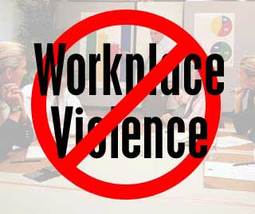|
by Joy Dike, PhD  Workplace violence is an unfortunate reality in today’s world. Domestic violence spilling over to the workplace, sexual harassment, physical violence, intimidation, threats, and disruptive behavior all occur at the workplace. It is well documented that workplace homicides are in decline, but other forms of workplace violence such as harassment, physical fighting, and verbal abuse are on the rise. In addition, active shooter incidents and mass shootings are on the rise. Employers have a legal and ethical obligation to provide a workplace free of threats and violence. So what can you do to address the issue of workplace violence at your place of business? Here are a few ideas to get you started:
There must be support from the top of a business or organization if there is going to be any meaningful action taken to address workplace violence. It is important to understand that here is no one-size-fits-all strategy to this issue. Each business, each organization, each campus or location will have different risks associated with it and thus require a unique plan. Read Here for a more in-depth look at workplace violence. by Joy Dike, PhD  Workplace violence is an unfortunate but important topic that all employers and employees need to consider. The issue of violence in the workplace has been addressed by OSHA, the CDC’s NIOSH (National Institute for Occupational Safety and Health), the FBI, the DOJ, and the National Center of Victims of Crime. According to OSHA, workplace violence is any act or threat of physical violence, harassment, intimidation, or other threatening or disruptive behavior that occurs at the work site. The news media sensationalizes workplace violence episodes like the Fort Hood shooting, the shooting of a Virginia news crew during a live broadcast, the shooting at Chattanooga military facilities, or the Washington Navy Yard shooting. These are tragic and alarming episodes, yes. The truth is, however, that the majority of workplace violence employers and managers have to deal with on a daily basis runs more along the lines of domestic violence, harassment, emotional abuse, and threats - not armed gunmen. Workplace violence causes ripple effects in terms of costs to the American economy. The Department of Justice estimates that workplace violence costs the American workforce over $30 billion annually; the FBI further explains this loss to include lost work time, lost wages, reduced productivity, medical costs, workers’ compensation payments, legal expenses, and security expenses. Beyond these tangible costs, workplace violence also creates anxiety, fear, and a climate of distrust in the workplace. It is well documented that individuals rarely snap and engage in workplace violence without first exhibiting behaviors of concern. Knowing and reporting these behaviors of concern is just as important as understanding the problem situations and risk factors that often precede behaviors of concern. Such behaviors of concern could include depression, threats, menacing behavior, erratic behavior, aggressive outburst, offensive conversation, jokes referring to violence, increasing tardiness, increasing absenteeism, worsening relationships with coworkers, decreased productivity, homicidal comments, increasing belligerence, hypersensitivity to criticism, and verbal abuse. Of course any of these behaviors alone is not necessarily more suggestive of potential workplace violence, but many of these behaviors taken together should raise warning flags. Continue to follow this blog as we look at how an Emergency Action Plan can help you address workplace violence. by Joy Dike, PhD  Is your place of business located in a multi-tenant building? It’s important that you take this fact in to account when creating your Emergency Management Plan. Consider the following situation: You’re on the 15th floor of your building. A tenant on the 4th floor has a deadly workplace violence incident. Police, fire, and other law enforcement and first responders are on the scene. There is chaos. There is fear. Your own employees are panicked. It would be great if the building as a whole had an Emergency Action Plan that covers incidents in the building. It would be doubly great if building management has shared that plan with you, one of the tenants. But let’s face it – this probably isn’t the situation in your multi-tenant office building. You need to have a plan of your own for your own emergencies and also for building-wide emergencies. But don’t forget to share your Emergency Action Plan with building management, local law enforcement, first responders, and other authorities. You don’t want to have an Emergency Action Plan that conflicts with one written by building management – that would cause even more chaos and fear. There needs to be communication in a multi-tenant office building. Continue to follow along with us as we talk more about Emergency Action Plans and things to consider while writing yours. by Joy Dike, PhD  I’m sure you have a fire evacuation plan at your place of business. In fact, you probably drill the evacuation procedures occasionally. That's great, considering it’s a federal regulation. So it’s good that you have a plan to keep employees safe in the eventuality of a fire. But did you know that the regulation saying you need to have a fire evacuation plan also regulates that you have an emergency action plan? Do you understand the difference between them? Consider, for a moment, this scenario: An armed gunman comes into your lobby threatening to shoot people. Your emergency plan dictates that someone gets on the intercom system to announce, “There’s a shooter in the building. Everyone follow the fire evacuation plan.” Think about how absurd this situation is. You are announcing to the shooter that everyone is about to come to the lobby! How convenient - he can just stay put and shoot at hundreds of people in just a few moments. Hopefully you can see how irrational this plan is. The sad fact is that most emergency action plans are written exactly like this. You NEED a plan for emergencies that goes above and beyond fire. This plan needs to be drawn up by professionals who understand your building layout, your company policies and procedures, and your security system. Without a plan, chaos will ensue. Continue to follow us over the next few days and we think about what factors to include in a good Emergency Action Plan. by Joy Dike, PhD If you’ve been following along with us over the course of the past few weeks, you’ve thought about some of the stranger (and less likely) situations that may arise in an emergency situation. To review, we’ve talked about:
Hopefully your business will never encounter these problems. Hopefully your business will be successful and carry on thriving for many years to come. But you need to do a Business Impact Analysis and you need to create a Business Continuity Plan. It’s just good business sense. Please, when you create, write, review, or update your business impact analysis and your business continuity plan, don’t forget about these unusual situations. You can’t answer questions like these by sitting down for 20 minutes and brainstorming what you’d do. You can’t just “wing it” and hope everything works out. You need to have professionals who are experts in business continuity planning help you write a business impact analysis and create a business continuity plan. You also need to write an Emergency Action Plan so that your business is prepared for what to do during an emergency. In light of recent national and world events, this is more important than ever before to have a risk assessment done and create an Emergency Action Plan. Continue following us as we move on to discussing Emergency Management Plans and why you also probably suck at writing one of those. by Joy Dike, PhD After the shock of these events has subsided, the logical question is to ask how you, the individual, can protect yourself. This is a normal reaction to terrorist events.
The truth is that the best thing you can do at your place of business, your child's school, or your place of worship is to have a PLAN IN PLACE in the event that a terrorist incident occurs. Think about what would happen if an armed gunman or a suicide bomber entered your place of work - someone may sound an alarm and everyone would follow the fire escape plan. Good idea? Is it a good idea to have everyone congregate in the lobby or right outside the building, as is usual for fire escape plans? Think about it for just a moment - there's a guy with a bomb whose overriding goal is to cause mass casualty, and your fire escape plan gives him exactly what he wants, huge numbers of people all congregated in one place. Just to be clear - this is a terrible plan. A fire evacuation plan is great for fire but not great for active shooters or bomb threats. Your place of business needs to have a plan in place for what to do in a situation like this. This is called an Emergency Action Plan, and it goes far above and beyond a simple fire evacuation plan. A proper Emergency Action Plan will have different plans for different scenarios - fire, cataclysmic weather, active shooter, or maybe even an irate parent or client. Don't wait until it's too late. Think about having a risk assessment done for your place of business. Ask your child's school administration if they've ever done a risk assessment and if they have an Emergency Action Plan (NOT just a fire evacuation plan). Ask the security guards at the front desk of your multi-story office building if there is an Emergency Action Plan for the building. Ask your boss if there is one for your company. Don't be afraid to speak up at your place of business or your child's school and ask about a risk assessment and an Emergency Action Plan.  Today’s Friday Factoid is the top ten OSHA violations for 2014. Do you know how compliant you are on any OSHA related requirements regarding your work environment? (Taken directly from the United States Department of Labor website for violations in 2014. https://www.osha.gov/oshstats/commonstats.html ) 1. Fall protection, construction (29 CFR 1926.501) 2. Hazard communication standard, general industry (29 CFR 1910.1200) 3. Scaffolding, general requirements, construction (29 CFR 1926.451) 4. Respiratory protection, general industry (29 CFR 1910.134) 5. Powered industrial trucks, general industry (29 CFR 1910.178) 6. Control of hazardous energy (lockout/tagout), general industry (29 CFR 1910.147) 7. Ladders, construction (29 CFR 1926.1053) 8. Electrical, wiring methods, components and equipment, general industry (29 CFR 1910.305) 9. Machinery and Machine Guarding, general requirements (29 CFR 1910.212) 10. Electrical systems design, general requirements, general industry (29 CFR 1910.303) We at Invictus Consulting LLC perform OSHA audits for companies frequently. Are you unsure of what your industry’s regulations are? Do you want to know your exposure? Contact us, we will be glad to help. Don’t wait to find out when it is too late.  We have presented the need for an active shooter plan to many different companies and have noticed an underlying theme when the management or decision makers are from outside the U.S. This is seen as an “American” problem. Regardless of where you politically/ideologically fall with regards to the 2nd Amendment arguments, we as Americans (U.S. Citizens) are widely viewed as gun toting crazies by other parts of the globe. Sort of a mixture of John Wayne and Rambo. This opinion often carries over into a bias against the need to for an active shooter plan. We are all aware of the shootings in Paris last week. Following is a link that contains information regarding several types of “spree killings” and is broken out by different continents. Rather alarming information. http://en.wikipedia.org/wiki/List_of_rampage_killers Having traveled the globe we can tell you that great people are everywhere. Sadly a universal truth among humanity is that a certain portion of the population are the exact opposite, and look to actively hurt others. People that want to do harm will find ways to do it. We have fire emergency plans which drastically reduce the loss of life in an emergency. We have inclement weather plans (tornado, hurricane, tsunami) which drastically reduce the loss of life in an emergency. Both of those scenarios have a small statistical chance of actually happening to you. But we prepare to be safe and prudent. Should the disaster of a crazed killer not garner that same attention? Office or school place mass killings are not just an American problem. We at Invictus Consulting LLC contend that having no plan is planning to fail. Failure in this area can mean the lives of our employees and coworkers. If you would like to discuss developing and implementing a plan the please contact us! |
Archives
June 2016
Categories
All
|




 RSS Feed
RSS Feed
